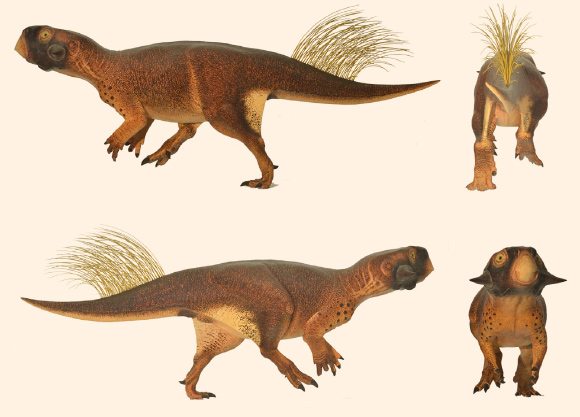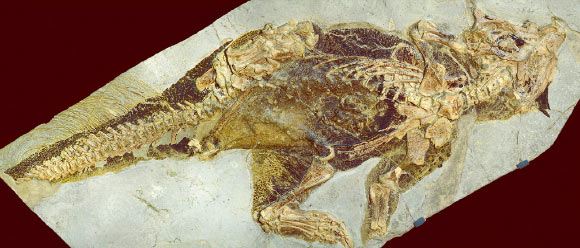A University of Bristol-led international team of paleontologists has produced an accurate reconstruction of an exceptionally well-preserved specimen of Psittacosaurus, a Cretaceous ornithischian dinosaur from China. The camouflage patterns on this fossil include countershading, which functions by counter illuminating shadows on the body of an organism.

Model of Psittacosaurus sp. based on skin and pigmentation patterns on the specimen from the Senckenberg Museum, Germany. Image credit: Jakob Vinther et al.
The team, co-headed by University of Bristol researchers Jakob Vinther and Innes Cuthill, found that Psittacosaurus, an early relative of the famed horned dinosaur Triceratops, was light on its underside and darker on top.
This color pattern, known as countershading, is a common form of camouflage in modern animals.
According to the scientists, Psittacosaurus most likely lived in an environment with diffuse light, such as in a forest.
“The fossil preserves clear countershading, which has been shown to function by counter-illuminating shadows on a body, thus making an animal appear optically flat to the eye of the beholder,” Dr. Vinther said.
“By reconstructing a life-size 3D model, we were able to not only see how the patterns of shading changed over the body, but also that it matched the sort of camouflage which would work best in a forested environment,” Prof. Cuthill added.
Countershading most likely served to protect this dinosaur species against predators that use patterns of shadow on an object to determine shape, just as humans do.
Dr. Vinther, Prof. Cuthill and their colleagues from the United States, the UK, Germany and Hong Kong realized that structures previously thought to be artifacts or dead bacteria in the dinosaur’s fossilized feathers were actually ‘melanosomes,’ small structures that carry melanin pigments found in the feathers and skin of many animals.
In some well-preserved specimens, such as Psittacosaurus in this study, it’s possible to make out the patterns of preserved melanin without the aid of a microscope.
“Our Psittacosaurus was reconstructed from the inside-out. There are thousands of scales, all different shapes and sizes, and many of them are only partially pigmented,” said team member Robert Nicholls, from Palaeocreations in Bristol, UK.
“It was a painstaking process but we now have the best suggestion as to what this dinosaur really looked like.”

Specimen of Psittacosaurus sp. photographed under crossed polarized light. Image credit: Jakob Vinther et al.
In order to investigate what environment Psittacosaurus had evolved to live in, the team took another cast of the model and painted it all grey. They then placed it in the Cretaceous plant section of Bristol Botanic Garden and photographed it under an open sky and underneath trees to see how the shadow was cast under those conditions.
By comparing the shadow to the pattern in the fossil they could then predict what environment this dinosaur lived in.
“We predicted that Psittacosaurus must have lived in a forest,” Dr. Vinther said.
“This demonstrates that fossil color patterns can provide not only a better picture of what extinct animals looked like, but they can also give new clues about extinct ecologies and habitats.”
“We were amazed to see how well these color patterns actually worked to camouflage this little dinosaur.”
The team’s findings were published online September 15, 2016 in the journal Current Biology.
_____
Jakob Vinther et al. 2016. 3D Camouflage in an Ornithischian Dinosaur. Current Biology 26: 1-7; doi: 10.1016/j.cub.2016.06.065







